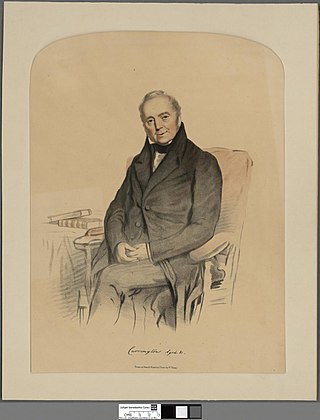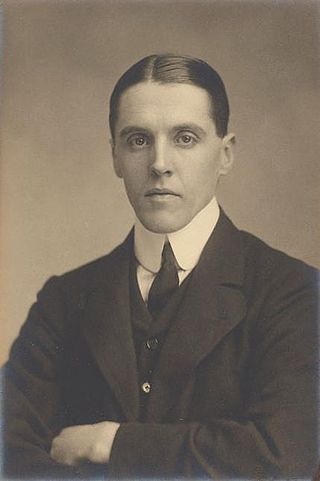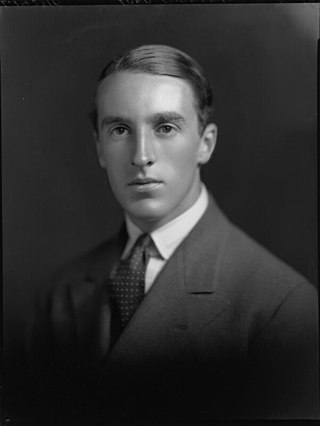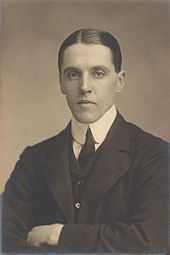
Marquess of Londonderry, of the County of Londonderry, is a title in the Peerage of Ireland.

Earl of Jersey, is a title in the Peerage of England. It is held by a branch of the Villiers family, which since 1819 has been the Child Villiers family.

Earl of Glasgow is a title in the Peerage of Scotland. It was created in 1703 for David Boyle, Lord Boyle.

Earl of Halifax is a title that has been created four times in British history—once in the Peerage of England, twice in the Peerage of Great Britain, and once in the Peerage of the United Kingdom. The name of the peerage refers to Halifax, West Yorkshire.

Earl Peel is a title in the Peerage of the United Kingdom. The Peel family descends from Robert Peel, eldest son of a wealthy cotton merchant. The family lands, known as Drayton Manor, in the County of Stafford would become more commonly known in modern-day as an amusement park. The family seat is Elmire House, near Ripon, North Yorkshire.

Earl of Bessborough is a title in the Peerage of Ireland. It was created in 1739 for Brabazon Ponsonby, 2nd Viscount Duncannon, who had previously represented Newtownards and County Kildare in the Irish House of Commons. In 1749, he was given the additional title of Baron Ponsonby of Sysonby, in the County of Leicester, in the Peerage of Great Britain, which entitled him to a seat in the British House of Lords. The titles Viscount Duncannon, of the fort of Duncannon in the County of Wexford, and Baron Bessborough, of Bessborough, Piltown, in the County of Kilkenny, had been created in the Peerage of Ireland in 1723 and 1721 respectively for Lord Bessborough's father William Ponsonby, who had earlier represented County Kilkenny in the Irish House of Commons.

Earl Cathcart is a title in the Peerage of the United Kingdom.

Earl Beatty is a title in the Peerage of the United Kingdom. It was created in 1919 for the prominent naval commander Admiral of the Fleet Sir David Beatty. He was created Baron Beatty, of the North Sea and of Brooksby in the County of Leicester, and Viscount Borodale, of Wexford in the County of Wexford, at the same time, also in the Peerage of the United Kingdom. The latter title is used as a courtesy title for the Earl's eldest son and heir apparent. Lord Beatty was succeeded by his eldest son, the second Earl. He represented Peckham in the House of Commons as a Conservative from 1931 to 1936 and briefly served as Under-Secretary of State for Air in Winston Churchill's 1945 caretaker government. As of 2014 the titles are held by his eldest son, the third Earl, who succeeded in 1972.

Earl of Durham is a title in the Peerage of the United Kingdom. It was created in 1833 for the Whig politician and colonial official John Lambton, 1st Baron Durham. Known as "Radical Jack", he played a leading role in the passing of the Great Reform Act of 1832. As Governor General of British North America, he was the author of the famous Report on the Affairs of British North America, known in Canada as the Durham Report. He had already been created Baron Durham, of the City of Durham and of Lambton Castle in the County Palatine of Durham, in 1828. He was created Viscount Lambton at the same time that he was raised to the earldom. These titles are also in the Peerage of the United Kingdom.

Earl Cowley is a title in the Peerage of the United Kingdom. It was created in 1857 for the diplomat Henry Wellesley, 2nd Baron Cowley. He was Ambassador to France from 1852 to 1867. He was made Viscount Dangan, of Dangan in the County of Meath, at the same time as he was given the earldom. This title is also in the Peerage of the United Kingdom. Lord Cowley was the eldest son of Henry Wellesley, 1st Baron Cowley, who like his son served as Ambassador to France. In 1828 he was created Baron Cowley, of Wellesley in the County of Somerset, in the Peerage of the United Kingdom. A member of the prominent Wellesley family, Cowley was the fifth and youngest son of Garret Wellesley, 1st Earl of Mornington, and the younger brother of Arthur Wellesley, 1st Duke of Wellington, and Richard Wellesley, 1st Marquess Wellesley.

Earl Cairns is a title in the Peerage of the United Kingdom. It was created in 1878 for the prominent lawyer and Conservative politician Hugh Cairns, 1st Baron Cairns. He was Lord High Chancellor of Great Britain in 1868 and from 1874 to 1880. Cairns had already been created Baron Cairns, of Garmoyle in the County of Antrim, in 1867, and was made Viscount Garmoyle, in the County of Antrim, at the same time he was given the earldom. These titles are also in the Peerage of the United Kingdom.

Earl of Cranbrook is a title in the Peerage of the United Kingdom, created in 1892 for Gathorne Gathorne-Hardy, Viscount Cranbrook. The title is named after Cranbrook in the county of Kent. The Gathorne-Hardy family seat is Great Glemham House, near Saxmundham, Suffolk.

Baron Carrington is a title that has been created three times, once in the Peerage of England, once in the Peerage of Ireland and once in the Peerage of Great Britain.

Baron Feversham is a title that has been created twice, once in the Peerage of Great Britain and once in the Peerage of the United Kingdom. The first creation, in the Peerage of Great Britain, came in 1747 when Anthony Duncombe, who had earlier represented Salisbury and Downton in the House of Commons, was made Lord Feversham, Baron of Downton, in the County of Wilts. He had previously inherited half of the enormous fortune of his uncle Sir Charles Duncombe. However, Lord Feversham had no sons and the barony became extinct on his death in 1763. The peerage was revived in the Peerage of the United Kingdom in 1826 in favour of his kinsman Charles Duncombe, who was created Baron Feversham, of Duncombe Park in the County of York. He was a former Member of Parliament for Shaftesbury, Aldborough, Heytesbury and Newport. Duncombe was the grandson of Thomas Duncombe, son of John Brown by his wife Ursula Duncombe, aunt of the first Baron of the 1747 creation. Ursula had inherited the other half of her brother Sir Charles Duncombe's fortune. Lord Feversham son, the second Baron, sat as a Conservative Member of Parliament for Yorkshire and the North Riding of Yorkshire.

Frederick Edwin Smith, 1st Earl of Birkenhead, was a British Conservative politician and barrister who attained high office in the early 20th century, in particular as Lord High Chancellor of Great Britain. He was a skilled orator, noted for his staunch opposition to Irish nationalism, his wit, pugnacious views, and hard living and drinking. He is perhaps best remembered today as Winston Churchill's greatest personal and political friend until Birkenhead's death aged 58 from pneumonia caused by cirrhosis of the liver.

Frederick Winston Furneaux Smith, 2nd Earl of Birkenhead was a British biographer and Member of the House of Lords. He is best known for writing a biography of Rudyard Kipling that was suppressed by the Kipling family for many years, and which he never lived to see in print.

Earl of Ellesmere, of Ellesmere in the County of Shropshire, is a title in the Peerage of the United Kingdom. It was created in 1846 for the Conservative politician Lord Francis Egerton. He was granted the subsidiary title of Viscount Brackley, of Brackley in the County of Northampton, at the same time, also in the Peerage of the United Kingdom. Born Lord Francis Leveson-Gower, he was the third son of George Leveson-Gower, 1st Duke of Sutherland and Elizabeth Gordon, 19th Countess of Sutherland. In 1803 his father had inherited the substantial estates of his maternal uncle Francis Egerton, 3rd Duke of Bridgewater. On his father's death in 1833, Lord Francis succeeded to the Egerton estates according to the will of the late Duke of Bridgewater, and assumed by Royal licence the surname of Egerton in lieu of Leveson-Gower. The Brackley and Ellesmere titles created for him in 1846 were revivals of titles held by the Dukes of Bridgewater. In 1963 his great-great-grandson, the fifth Earl, succeeded his kinsman as 6th Duke of Sutherland. The earldom of Ellesmere and viscountcy of Brackley are now subsidiary titles of the dukedom.

Earl Brassey was a title in the Peerage of the United Kingdom. It was created in 1911 for the Liberal politician and former Governor of Victoria, Australia, Thomas Brassey, 1st Baron Brassey, eldest son of the railway magnate Thomas Brassey (1805-1870). He had already been created Baron Brassey, of Bulkeley in the County Palatine of Chester, in 1886, and was made Viscount Hythe, of Hythe in the County of Kent, at the same time as he was granted the earldom. These titles were also in the Peerage of the United Kingdom. The titles became extinct upon the death of his son, the second Earl, in 1919.
Frederick William Robin Smith, 3rd Earl of Birkenhead was a British writer, historian and hereditary peer. He wrote under the pseudonym Robin Furneaux.

Earl of Arran is a title in the Peerage of Ireland. It is not to be confused with the title Earl of Arran in the Peerage of Scotland. The two titles refer to different places: the Aran Islands in Ireland, and the Isle of Arran in Scotland. The Irish earldom is held by the Gore family. The Scottish earldom is a separate title, held as a subsidiary title of the Duke of Hamilton.












